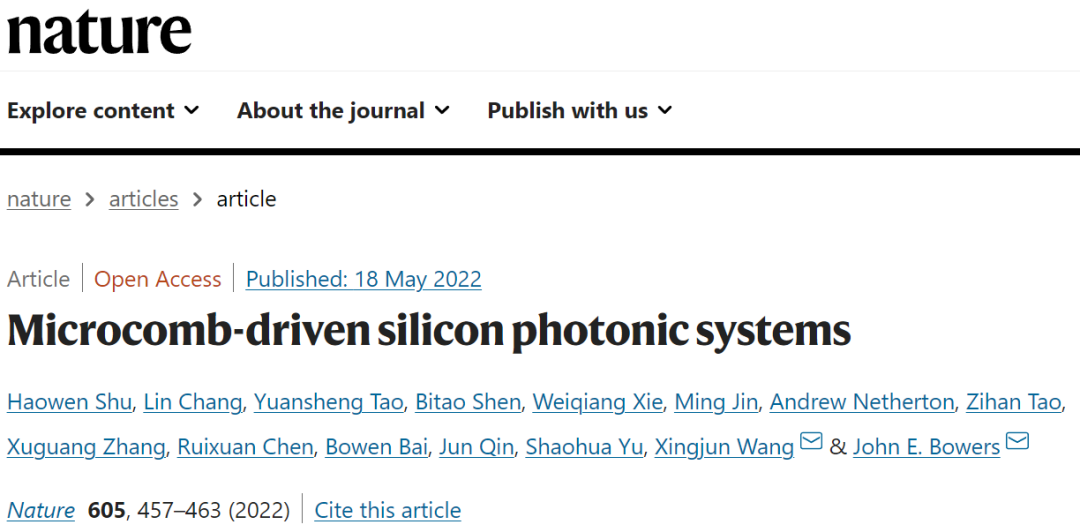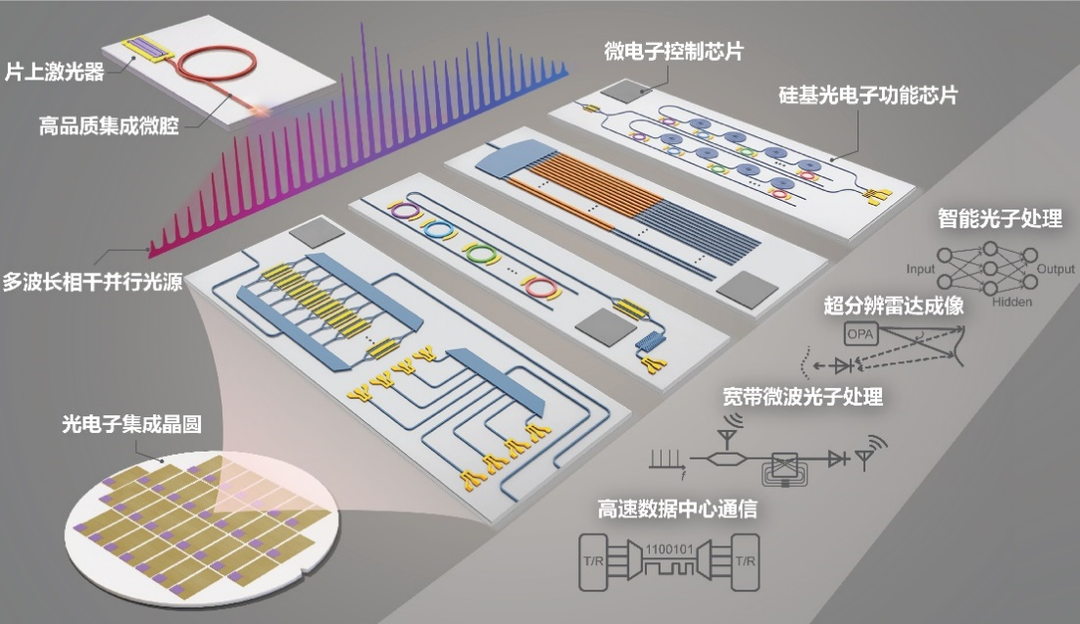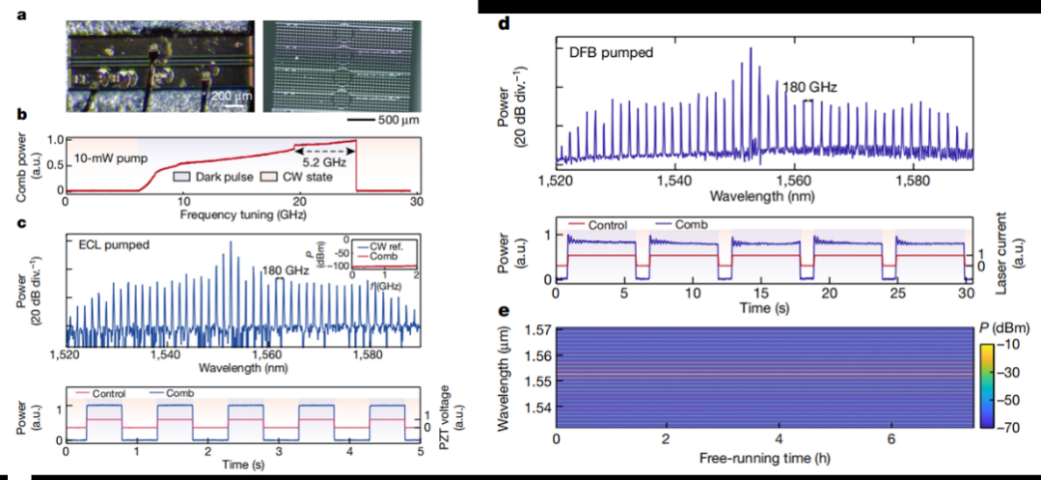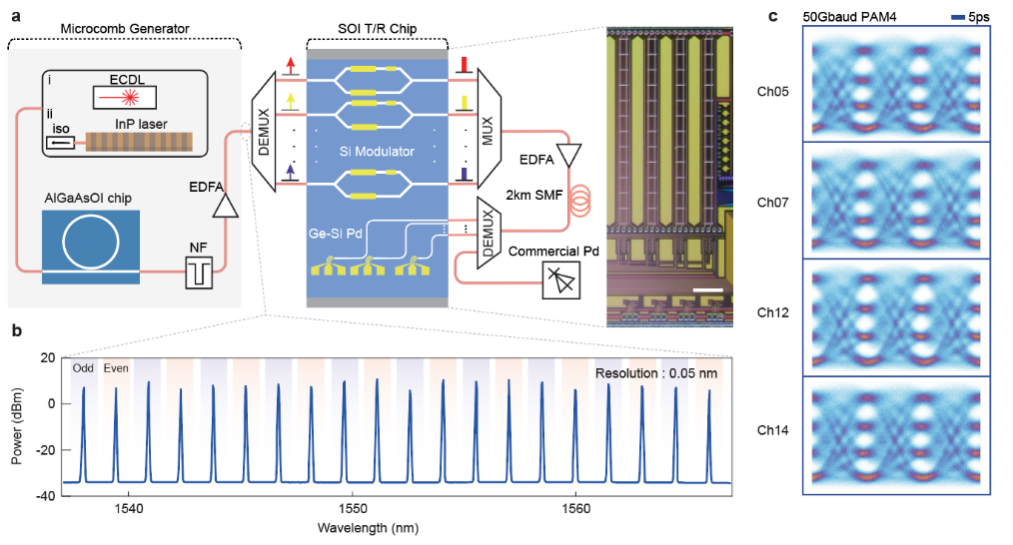Breakthrough! Microcomb-driven Silicon Photonic Systems
Jun 01, 2022
Peking University, June 1, 2022: Optical frequency combs have long been a hot research topic in the international optics field due to its wide range of uses. On May 18, 2022, researchers from Peking University led by Prof. Wang Xingjun and the University of California, Santa Barbara led by Prof. John Bowers published a groundbreaking paper in the journal Nature, titled "Microcomb-driven silicon photonic systems".
In the paper, the research team unveiled an integrated solution for highly parallel optoelectronic systems. While microcombs and highly customized silicon photonic chips are designed and fabricated to offer multiple optoelectronic functionalities, this work paves the way towards the full integration of a wide range of optical systems, and will significantly accelerate the proliferation of microcombs and SiPh technologies for the next generation of integrated photonics.
 Fig.1 Snapshot of the newly published work
Fig.1 Snapshot of the newly published work
This paper is the outcome of 3 years of research and countless hardships, but what exactly makes it important? How did the research team achieve a breakthrough and how does this technology contribute to our lives? Let's try to understand this piece of complex science by consulting the master, Prof. Wang!
How is this research significant?
Optical frequency combs are one of the most important technologies in metrology in the past 30 years, which earned Hall and Hänsch a share of the 2005 Nobel Prize in Physics. Known as the third generation of frequency combs, the microcombs—offering the prospect of generating and measuring optical frequencies using very cheap and compact devices that can be fabricated on a chip—have sparked a surge of applications well beyond metrology and fundamental physics to areas such as telecommunications, spectroscopy and laser ranging. Despite their diverse deployment, most microcomb-based systems rely on a large number of bulky elements and equipment to fulfill their desired functions, which is complicated, expensive and power-consuming, thereby undermining the promised benefits of integrated photonics.
 Fig.2 Conceptual drawings for microcomb-driven silicon photonic systems
Fig.2 Conceptual drawings for microcomb-driven silicon photonic systems
In contrast, the advances in silicon photonics (SiPh) technology have provided a scalable and low-cost solution to miniaturize optical systems, benefiting from complementary metal–oxide–semiconductor (CMOS)-compatible manufacturing. These 'photonic engines' have been commercialized in data interconnects and have also been widely applied in other fields. Now, silicon photonics is undergoing a continuous scaling-up for higher data capacity, faster processing speed and larger information throughput. Yet, a key ingredient missing from foundry-based silicon-on-insulator (SOI) photonic integrated circuits (PICs) is the multiple wavelength source. Increasing the channel count in such a system requires considerable design effort, such as line-to-line spacing stabilization and increased assembly workload.
Although it seems that interfacing these two technologies is essential to address the aforementioned problems on both sides, up until now, a large number of engineering and science issues in such a combination has remained elusive and unexplored.
How did the research team achieve a breakthrough?
The researchers make a key step in combining these two essential technologies. Using an aluminum gallium arsenide (AlGaAs)-on-insulator (AlGaAsOI) microresonator that can be directly pumped by a DFB on-chip laser, a dark-pulse microcomb is generated, which exhibits state-of-the-art efficiency, simple operation and long-time stability. Such a coherent comb is used to drive CMOS-foundry-based SiPh engines containing versatile functionality, which can be used for a wide range of applications such as data transmission, microwave photonic signal processing, optical beam steering and photonic computing.
 Fig.2 Conceptual drawings for microcomb-driven silicon photonic systems
Fig.2 Conceptual drawings for microcomb-driven silicon photonic systems
On the basis of this approach, system-level demonstrations are presented for two major integrated photonics fields. (1) As a communications demonstration, a microcomb-SiPh transceiver-based data link is presented with 100-Gbps pulse-amplitude four-level modulation (PAM4) transmission and 2-Tbps aggregate rate for data centres. (2) For microwave photonics, a compact microwave filter is demonstrated with tens-of-microseconds-level reconfiguration speed by an on-chip multitap delay-line processing scheme, whose tunable bandwidth and flexible centre frequency are capable of supporting fifth-generation (5G), radar and on-chip signal processing.
 Fig.3 Conceptual drawings for microcomb-driven silicon photonic systems
Fig.3 Conceptual drawings for microcomb-driven silicon photonic systems
Considering the versatility offered by the technologies, such microcomb-driven SiPh systems will provide a mass-produced and low-cost solution to a broad range of optoelectronics applications, therefore facilitating the next generation of integrated photonics in the fields of data transmission, microwave photonics, Lidar, optical neural network and etc.
Source: Nature, Prof. Wang Xingjun Research Team
Editor: Chan Zi Qing
Executive Editor: Guo Yasong



